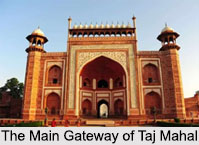 The main gateway of Taj Mahal or the Darwaza-i-Rauza was constructed between the years 1632-1638. The gate was designed by the architect named, Ustad Ahmad Lahauri, which was confirmed based on the writings of his son Lutfullah Munhadis.
The main gateway of Taj Mahal or the Darwaza-i-Rauza was constructed between the years 1632-1638. The gate was designed by the architect named, Ustad Ahmad Lahauri, which was confirmed based on the writings of his son Lutfullah Munhadis.
The main gateway of the Taj Mahal leads to the marble dome. This innocuous gate displays the carved Hindu motifs on them. According to Islam a gateway signifies passing from a materialistic world of senses into a divine world of spirit. The gateway is one of the five important elements of Taj Mahal, which was the main entrance during its construction. The double-storey main gateway of the Taj Mahal, 93 feet high and 150 feet wide, is built in red sandstone. The doorway is of ogival arch shape that reaches the gateway structure till the mid-height of it.
There are octagonal shaped towers at the corners of the main gateway, which are surrounded by open-doomed pavilion. Over the central portion of the gateway, there are 11 umbrella shaped marble cupolas. A big decorated arched chamber lies in the archway of the main gate. It has rooms with twists, branches and side branches to hallways. It was most probably built to confuse people from entering them. These rooms have not been used for about three centuries.
The Arabic calligraphy from the Holy Quran and motifs of entwined flowers, leaves and vines are spiraling down its niches. These motifs have been made by semi-precious stones inlaid in the white marble. As one enters the gateway, a lovely arch spreads out in the shape of double-storey wings. It seems as if someone is welcoming the visitors with their stretched arms. What further beautifies the gateway to the Taj Mahal is the image of a white teardrop with a red trident. The sculpture of the gateway reflects the Hindu style. In fact the red lotus here stands for the Hindu God Lord Brahma.



















